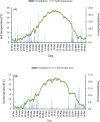Weed community changes in saffron+chickpea intercropping under different irrigation management
- PMID: 37235596
- PMCID: PMC10218734
- DOI: 10.1371/journal.pone.0286474
Weed community changes in saffron+chickpea intercropping under different irrigation management
Abstract
Saffron (Crocus sativus L.) is among the world's most expensive crops; nevertheless, it struggles to compete with weeds. Non-chemical farming practices, such as intercropping and reduced irrigation, can help to decrease weed problems. Therefore, this study aimed to evaluate the changes in the weed density, biomass and weed diversity under saffron-chickpea intercropping system with two irrigation regimes. The study's treatments included two irrigation regimes, namely one-time irrigation and conventional irrigation (carried out four times from October through May), and six planting ratios of saffron and chickpea, namely saffron sole-crop (C1), chickpea sole-crop (C2) in eight rows, 1:1 (C3), 2:2 (C4), 2:1 (C5), and 3:1 (C6)] as main and sub-plots, respectively. The result showed that the conventional irrigation regimes increased weed diversity, however, it didn't affect the Pielou index. Intercropping ratios decreased weed diversity compared to saffron and chickpea mono-cropping systems. The interaction effect of treatments was significant for weed density and weed biomass. In most intercropping ratios, weed density and weed biomass decreased under one-time irrigation regimes. The lowest values for weed density and biomass were observed with an average of 15.5 plants/m2 and 37.51 g/m2, respectively, under the one-time irrigation regime with C4 intercropping systems. This intercropping system did not show a significant difference with C3. Overall, the results indicate that a one-time irrigation regime and intercropping with chickpea, specifically with a 1:1 saffron-chickpea ratio (C3) and a 2:2 saffron-chickpea ratio (C4), could be effective strategies for weed management in saffron in semiarid cropping systems.
Copyright: © 2023 Mohammadkhani et al. This is an open access article distributed under the terms of the Creative Commons Attribution License, which permits unrestricted use, distribution, and reproduction in any medium, provided the original author and source are credited.
Conflict of interest statement
The authors have declared that no competing interests exist.
Figures






Similar articles
-
Effect of diverse crop establishment techniques and weed management approaches in rice-chickpea cropping systems on soil attributes.BMC Plant Biol. 2025 Mar 24;25(1):372. doi: 10.1186/s12870-025-06369-1. BMC Plant Biol. 2025. PMID: 40122795 Free PMC article.
-
Influence of relay intercropping of barley with chickpea on biochemical characteristics and yield under water stress.PLoS One. 2023 Jun 8;18(6):e0273272. doi: 10.1371/journal.pone.0273272. eCollection 2023. PLoS One. 2023. PMID: 37289819 Free PMC article.
-
Crop Rotation and Intercropping Strategies for Weed Management.Ecol Appl. 1993 Feb;3(1):92-122. doi: 10.2307/1941795. Ecol Appl. 1993. PMID: 27759234
-
Phytochemistry, quality control and medicinal uses of Saffron (Crocus sativus L.): an updated review.J Med Life. 2023 Jun;16(6):822-836. doi: 10.25122/jml-2022-0353. J Med Life. 2023. PMID: 37675158 Free PMC article. Review.
-
The Potential of Cover Crops for Weed Management: A Sole Tool or Component of an Integrated Weed Management System?Plants (Basel). 2023 Feb 8;12(4):752. doi: 10.3390/plants12040752. Plants (Basel). 2023. PMID: 36840100 Free PMC article. Review.
Cited by
-
Effects of saffron-grape intercropping on saffron flower number and rhizosphere microbial community.BMC Microbiol. 2024 Dec 30;24(1):551. doi: 10.1186/s12866-024-03716-4. BMC Microbiol. 2024. PMID: 39736513 Free PMC article.
-
Enhancing production efficiency through optimizing plant density in maize-soybean strip intercropping.Front Plant Sci. 2024 Oct 11;15:1473786. doi: 10.3389/fpls.2024.1473786. eCollection 2024. Front Plant Sci. 2024. PMID: 39464277 Free PMC article.
-
Long-Term Year-Interval Effect of Continuous Maize/Soybean Intercropping on Maize Yield and Phosphorus Use Efficiency.Plants (Basel). 2025 Mar 29;14(7):1060. doi: 10.3390/plants14071060. Plants (Basel). 2025. PMID: 40219127 Free PMC article.
References
-
- Leone S, Recinella L, Chiavaroli A, Orlando G, Ferrante C, Leporini L, et al.. Phytotherapic use of the Crocus sativus L.(Saffron) and its potential applications: A brief overview. Phytotherapy Research. 2018;32(12):2364–75. - PubMed
-
- Saffron Pandita D. (Crocus sativus L.): Phytochemistry, therapeutic significance and omics- based biology. Medicinal and Aromatic Plants: Elsevier; 2021. p. 325–96.
-
- Jan S, Wani AA, Kamili AN, Kashtwari M. Distribution, chemical composition and medicinal importance of saffron(Crocus sativus L.). African Journal of Plant Science. 2014;8(12):537–45.
-
- Shahnoushi N, Abolhassani L, Kavakebi V, Reed M, Saghaian S. Economic analysis of saffron production. Saffron: Elsevier; 2020. p. 337–56.
-
- Dastranj M, Sepaskhah AR. Saffron response to irrigation regime, salinity and planting method. Scientia Horticulturae. 2019;251:215–24.
MeSH terms
LinkOut - more resources
Full Text Sources
Miscellaneous

